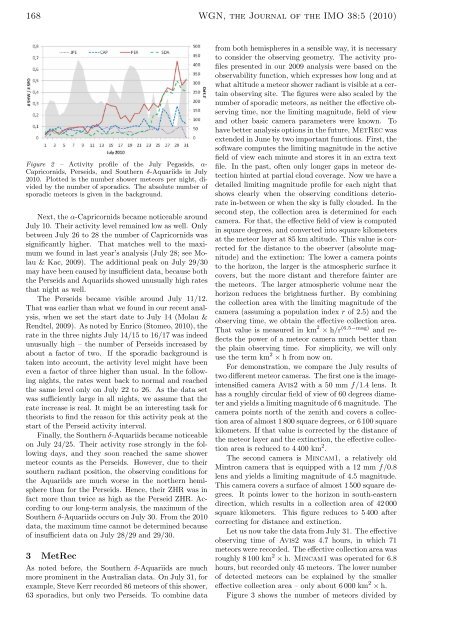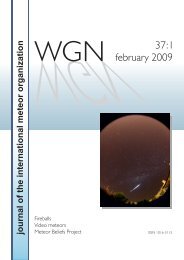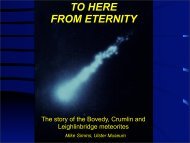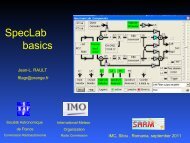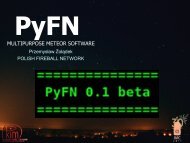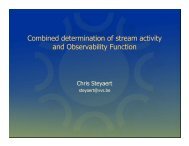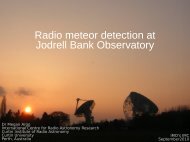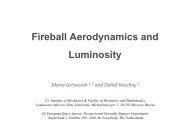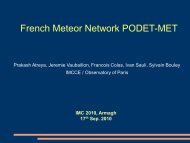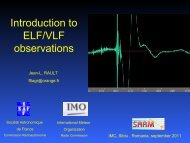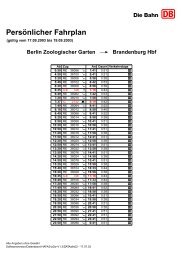Untitled - International Meteor Organization
Untitled - International Meteor Organization
Untitled - International Meteor Organization
You also want an ePaper? Increase the reach of your titles
YUMPU automatically turns print PDFs into web optimized ePapers that Google loves.
168 WGN, the Journal of the IMO 38:5 (2010)<br />
Figure 2 – Activity profile of the July Pegasids, α-<br />
Capricornids, Perseids, and Southern δ-Aquariids in July<br />
2010. Plotted is the number shower meteors per night, divided<br />
by the number of sporadics. The absolute number of<br />
sporadic meteors is given in the background.<br />
Next, the α-Capricornids became noticeable around<br />
July 10. Their activity level remained low as well. Only<br />
between July 26 to 28 the number of Capricornids was<br />
significantly higher. That matches well to the maximum<br />
we found in last year’s analysis (July 28; see Molau<br />
& Kac, 2009). The additional peak on July 29/30<br />
may have been caused by insufficient data, because both<br />
the Perseids and Aquariids showed unusually high rates<br />
that night as well.<br />
The Perseids became visible around July 11/12.<br />
That was earlier than what we found in our recent analysis,<br />
when we set the start date to July 14 (Molau &<br />
Rendtel, 2009). As noted by Enrico (Stomeo, 2010), the<br />
rate in the three nights July 14/15 to 16/17 was indeed<br />
unusually high – the number of Perseids increased by<br />
about a factor of two. If the sporadic background is<br />
taken into account, the activity level might have been<br />
even a factor of three higher than usual. In the following<br />
nights, the rates went back to normal and reached<br />
the same level only on July 22 to 26. As the data set<br />
was sufficiently large in all nights, we assume that the<br />
rate increase is real. It might be an interesting task for<br />
theorists to find the reason for this activity peak at the<br />
start of the Perseid activity interval.<br />
Finally, the Southern δ-Aquariids became noticeable<br />
on July 24/25. Their activity rose strongly in the following<br />
days, and they soon reached the same shower<br />
meteor counts as the Perseids. However, due to their<br />
southern radiant position, the observing conditions for<br />
the Aquariids are much worse in the northern hemisphere<br />
than for the Perseids. Hence, their ZHR was in<br />
fact more than twice as high as the Perseid ZHR. According<br />
to our long-term analysis, the maximum of the<br />
Southern δ-Aquariids occurs on July 30. From the 2010<br />
data, the maximum time cannot be determined because<br />
of insufficient data on July 28/29 and 29/30.<br />
3 MetRec<br />
As noted before, the Southern δ-Aquariids are much<br />
more prominent in the Australian data. On July 31, for<br />
example, Steve Kerr recorded 86 meteors of this shower,<br />
63 sporadics, but only two Perseids. To combine data<br />
from both hemispheres in a sensible way, it is necessary<br />
to consider the observing geometry. The activity profiles<br />
presented in our 2009 analysis were based on the<br />
observability function, which expresses how long and at<br />
what altitude a meteor shower radiant is visible at a certain<br />
observing site. The figures were also scaled by the<br />
number of sporadic meteors, as neither the effective observing<br />
time, nor the limiting magnitude, field of view<br />
and other basic camera parameters were known. To<br />
have better analysis options in the future, MetRec was<br />
extended in June by two important functions. First, the<br />
software computes the limiting magnitude in the active<br />
field of view each minute and stores it in an extra text<br />
file. In the past, often only longer gaps in meteor detection<br />
hinted at partial cloud coverage. Now we have a<br />
detailed limiting magnitude profile for each night that<br />
shows clearly when the observing conditions deteriorate<br />
in-between or when the sky is fully clouded. In the<br />
second step, the collection area is determined for each<br />
camera. For that, the effective field of view is computed<br />
in square degrees, and converted into square kilometers<br />
at the meteor layer at 85 km altitude. This value is corrected<br />
for the distance to the observer (absolute magnitude)<br />
and the extinction: The lower a camera points<br />
to the horizon, the larger is the atmospheric surface it<br />
covers, but the more distant and therefore fainter are<br />
the meteors. The larger atmospheric volume near the<br />
horizon reduces the brightness further. By combining<br />
the collection area with the limiting magnitude of the<br />
camera (assuming a population index r of 2.5) and the<br />
observing time, we obtain the effective collection area.<br />
That value is measured in km 2 × h/r (6.5−mag) and reflects<br />
the power of a meteor camera much better than<br />
the plain observing time. For simplicity, we will only<br />
use the term km 2 × h from now on.<br />
For demonstration, we compare the July results of<br />
two different meteor cameras. The first one is the imageintensified<br />
camera Avis2 with a 50 mm f/1.4 lens. It<br />
has a roughly circular field of view of 60 degrees diameter<br />
and yields a limiting magnitude of 6 magnitude. The<br />
camera points north of the zenith and covers a collection<br />
area of almost 1 800 square degrees, or 6100 square<br />
kilometers. If that value is corrected by the distance of<br />
the meteor layer and the extinction, the effective collection<br />
area is reduced to 4400 km 2 .<br />
The second camera is Mincam1, a relatively old<br />
Mintron camera that is equipped with a 12 mm f/0.8<br />
lens and yields a limiting magnitude of 4.5 magnitude.<br />
This camera covers a surface of almost 1500 square degrees.<br />
It points lower to the horizon in south-eastern<br />
direction, which results in a collection area of 42000<br />
square kilometers. This figure reduces to 5400 after<br />
correcting for distance and extinction.<br />
Let us now take the data from July 31. The effective<br />
observing time of Avis2 was 4.7 hours, in which 71<br />
meteors were recorded. The effective collection area was<br />
roughly 8 100 km 2 × h. Mincam1 was operated for 6.8<br />
hours, but recorded only 45 meteors. The lower number<br />
of detected meteors can be explained by the smaller<br />
effective collection area – only about 6 000 km 2 × h.<br />
Figure 3 shows the number of meteors divided by


